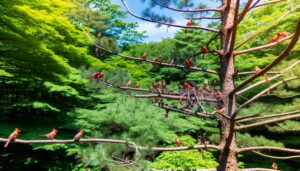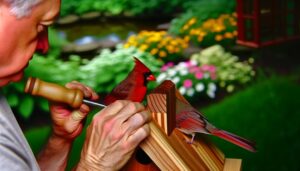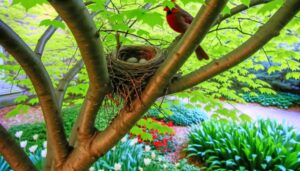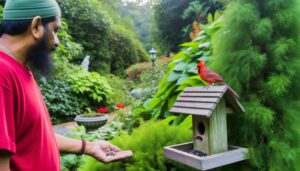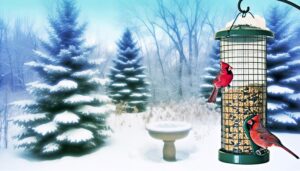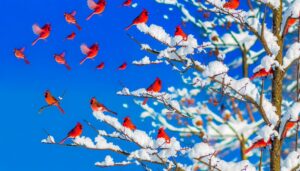7 Tips to Attract Cardinals to Your Iowa Garden
To attract cardinals in Iowa, start with sturdy feeders that have ample space and are positioned about 5-6 feet above the ground. Offer black-oil sunflower seeds, safflower seeds, crushed peanuts, cracked corn, and dried fruit instead of small seeds.
Plant native shrubs and trees like dogwood and serviceberry to provide natural shelter and a layered habitat. Guarantee a fresh water source by keeping a shaded bird bath clean and unfrozen in winter.
Provide safe, dense shrubbery for nesting, and avoid pesticides. These steps create an inviting environment for cardinals—there's still more to discover.
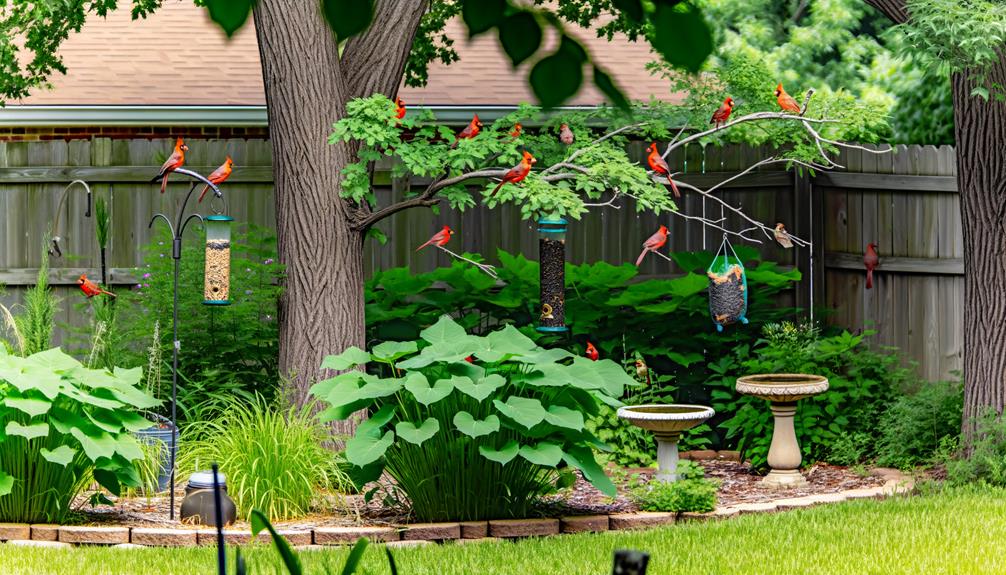
Key Takeaways
- Use feeders with sturdy perches and ample space, positioned 5-6 feet off the ground.
- Offer black-oil sunflower seeds, safflower seeds, crushed peanuts, cracked corn, and dried fruit.
- Plant Iowa-native shrubs and trees like dogwood and serviceberry for natural shelter.
- Provide a clean, shaded bird bath with a heater in winter, near shrubs or trees.
- Ensure dense shrubbery and evergreen trees for nesting, avoiding pesticide use.
Choose the Right Feeders
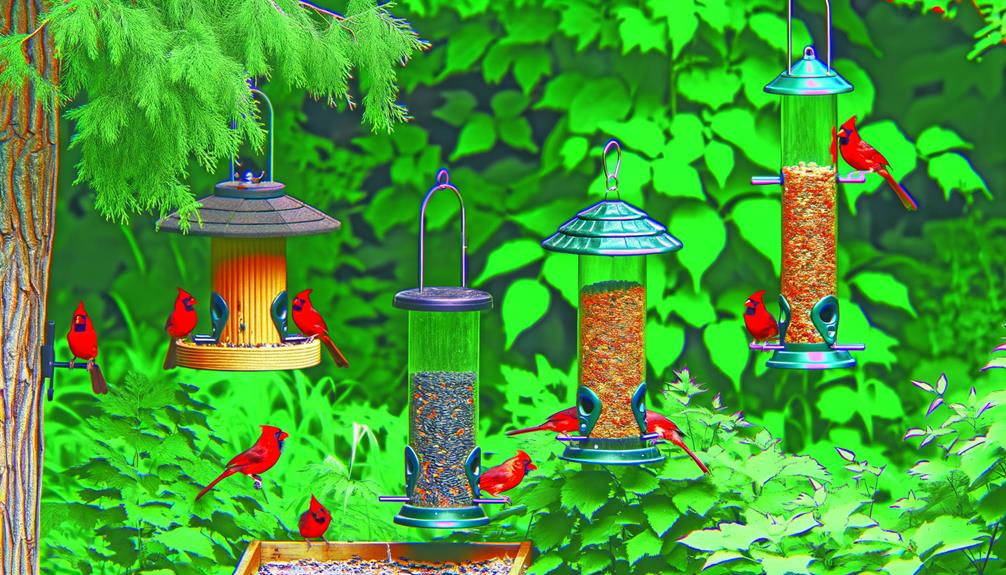
To attract cardinals effectively, you'll need to select feeders that cater specifically to their size and feeding habits. Opt for feeders with sturdy perches and ample space, as cardinals are medium-sized birds that require stability while feeding. Tube feeders with large ports or hopper feeders with wide trays work well.
Guarantee the feeder is made of durable materials to withstand Iowa's weather conditions. Place feeders in locations that offer both visibility and safety—near shrubs or trees where cardinals can quickly retreat if threatened. Make certain the feeder's height is accessible, around 5-6 feet off the ground, to deter ground predators.
Cleaning feeders regularly will also help maintain a healthy environment for your feathered visitors.
Select Cardinal-Friendly Food
Wondering what kind of food will attract cardinals to your feeder in Iowa? Cardinals love sunflower seeds, especially black-oil sunflower seeds. These seeds have a high fat content, providing essential energy during Iowa's cold winters.
You can also offer safflower seeds, which cardinals adore but squirrels often avoid. Incorporate crushed peanuts and cracked corn to diversify their diet and mimic their natural foraging habits.
For an extra treat, try offering dried fruit like raisins or currants. Remember, cardinals have strong beaks designed to crack open seeds, so avoid small seeds like millet.
Plant Native Shrubs and Trees
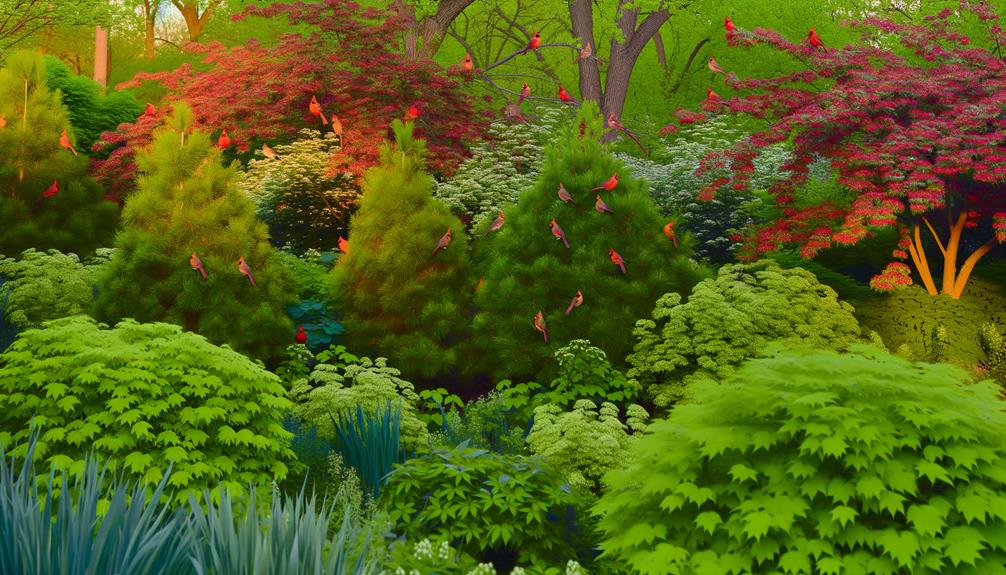
In addition to offering the right food, planting indigenous shrubs and trees provides cardinals with natural shelter and nesting sites, enhancing your backyard as a cardinal-friendly habitat. Opt for Iowa-native species like dogwood, serviceberry, and eastern red cedar.
These plants offer dense foliage for protection against predators and harsh weather. Cardinals prefer nesting in dense, low-lying shrubs or trees about 3-15 feet off the ground. By incorporating a variety of heights and types, you create a layered environment that meets their needs year-round.
Additionally, native plants support the local ecosystem, benefiting more than just cardinals. Aim for a diverse mix to guarantee a thriving habitat that promotes freedom and natural behavior for these vibrant birds.
Provide Fresh Water Sources
Make sure you place your bird bath in a shaded area to keep the water cool and attract cardinals.
Regularly clean the water source to prevent algae buildup and harmful bacteria.
During winter, use a bird bath heater to keep the water from freezing, guaranteeing a consistent supply.
Bird Bath Placement
To attract cardinals in Iowa, position your bird bath in a shaded, quiet area to keep the water cool and prevent rapid evaporation. Cardinals prefer secluded spots away from predators and heavy foot traffic. Place the bird bath near shrubs or trees, which offer refuge and a quick escape route. This strategic placement mimics natural watering sites, making cardinals feel secure.
Assure the bath is at ground level or slightly elevated, replicating natural puddles they'd encounter in the wild. Opt for a shallow design, about 2 to 3 inches deep, to suit the cardinals' preference for wading. Remember, providing a consistent, fresh water source will significantly increase your chances of attracting these vibrant birds to your yard.
Water Source Cleanliness
Maintaining a clean water source is vital for attracting cardinals and preventing the spread of diseases. You should clean your bird bath every few days to make certain it remains hygienic. Use a scrub brush and mild bleach solution (1 part bleach to 9 parts water) to eliminate algae and debris. Rinse thoroughly to avoid chemical residues.
Here's a quick guide:
| Frequency | Action |
|---|---|
| Daily | Refill with fresh water |
| Every 3-4 days | Scrub and rinse bird bath |
| Weekly | Deep clean with bleach solution |
| As needed | Check for algae or debris |
Prevent Freezing Water
In colder months, preventing your bird bath from freezing is crucial to providing a consistent water source for cardinals. You can use a heated bird bath or add a bird bath heater to keep the water from freezing.
Make sure the heater is safe and energy-efficient. Regularly check the water level and clean any debris to maintain hygiene. Position the bird bath in a sunny spot to leverage natural heat, and use dark-colored basins to absorb more sunlight.
Ensure Safe Shelter Options
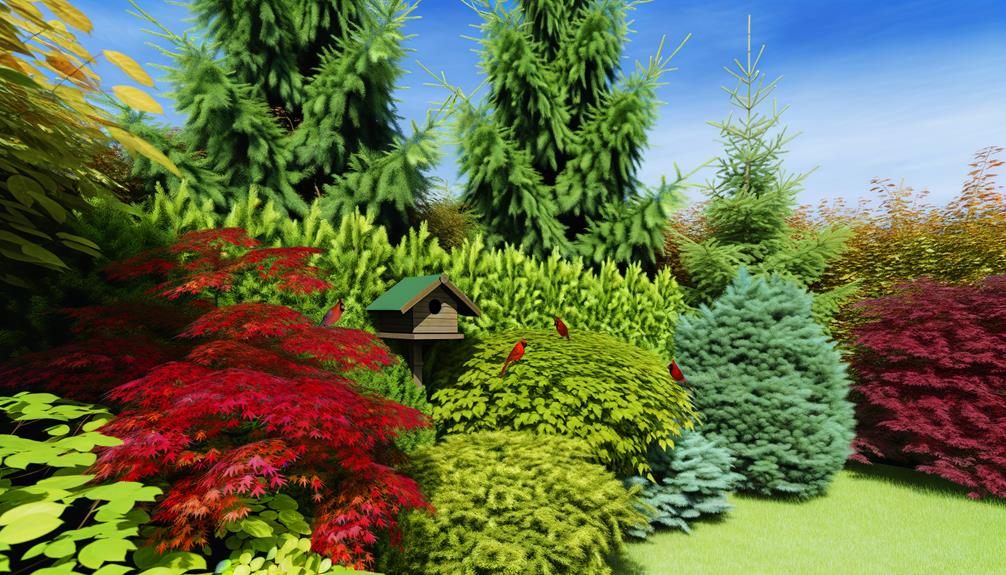
Creating a safe haven for cardinals involves providing dense shrubbery and evergreen trees where they can nest and find refuge from predators. You should plant native shrubs like dogwood and serviceberry, which offer both cover and food.
Evergreen trees, such as spruce or pine, provide year-round protection from the elements. Cardinals prefer thickets and areas with dense foliage, so aim to create layered plantings that mimic their natural habitat. Avoid using pesticides, as they can harm the birds and their prey.
Maintain a Clean Feeding Area
To maintain a clean feeding area, you should remove fallen seeds regularly to prevent mold and bacteria growth. Clean your feeders frequently to minimize the risk of disease transmission among birds.
These practices will create a healthier environment that attracts cardinals to your yard.
Remove Fallen Seeds Regularly
Regularly clearing away fallen seeds and debris from your feeding area is crucial for preventing the spread of disease and deterring pests. When seeds accumulate on the ground, they can become damp and moldy, creating a breeding ground for harmful bacteria and fungi. These pathogens can infect cardinals and other birds, jeopardizing their health.
Additionally, fallen seeds attract unwanted pests like rats, squirrels, and insects, which can disrupt the peaceful environment you've created.
To maintain a clean feeding area, use a rake or broom to gather and dispose of any scattered seeds. Perform this task daily to ensure ideal hygiene. This simple yet effective practice helps create a safe, inviting habitat for cardinals, allowing you to enjoy their vibrant presence freely.
Clean Feeders Frequently
Keeping your bird feeders clean is fundamental to preventing the spread of diseases among cardinals and other avian visitors. You should clean your feeders at least once a week with a solution of one part bleach to nine parts water. Make sure to scrub off any debris and rinse thoroughly with clean water.
This practice not only maintains a healthy environment but also keeps the food appealing to cardinals. Monitor the feeders regularly for mold or spoiled seeds, and replace them immediately if needed. Additionally, consider rotating feeders to allow one to dry completely while the other is in use.
Conclusion
By following these steps, you'll create a haven for cardinals reminiscent of Thoreau's Walden.
Choose the right feeders, offer sunflower seeds, and plant native flora to provide food and shelter.
Fresh water sources and safe, clean spaces will guarantee their comfort.
As you cultivate this sanctuary, you'll witness the vibrant reds and melodic chirps that signal a thriving cardinal population, transforming your Iowa backyard into a living masterpiece of nature.

